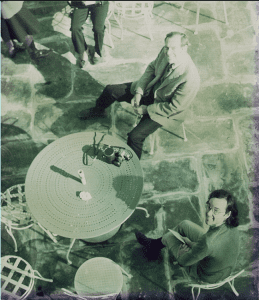

This article is Part 1 in a series about The Grail Romances of the Middle Ages and the Individuation Process by Lans Smith
 My connection with Joseph Campbell began with a journey, a dream, and a poem. Not knowing what I wanted to do after graduating from Williams College in 1972, I decided to get a degree in Creative Writing, and so went abroad for the first time to spend a year and a half in London and Dublin. Crossing the Irish Channel, on seas traveled by Tristan and Isolde, I had a powerful dream about a young woman I had met on the journey:
My connection with Joseph Campbell began with a journey, a dream, and a poem. Not knowing what I wanted to do after graduating from Williams College in 1972, I decided to get a degree in Creative Writing, and so went abroad for the first time to spend a year and a half in London and Dublin. Crossing the Irish Channel, on seas traveled by Tristan and Isolde, I had a powerful dream about a young woman I had met on the journey:
I am on a ferryboat leaving an old marina at night. After passing by the stone sea wall surrounding the marina, the ship hits the open sea. It is very dark, and the ship strikes something in the water, and then slowly begins to revolve in an accelerating spiral. I realize that this is because the ship has sliced right through the body of a gigantic sea serpent, and has begun to spin. I go over to the railings on the deck, and look down into the water. I see a foaming whirlpool, streaked with the blood of drowning sailors. From the depths of the whirlpool, a girl slowly surfaces. I reach down to pull her up onto the deck. She is naked, with scaly thighs. I give her to the crewmembers who come to take her away. When she comes back, she is dressed in the clothes of the girl I have just met during the crossing of the Irish Sea, from Hollyhead to Dublin.
After I told her about the dream, she said that she had some books for me to read, Joseph Campbell’s The Hero with a Thousand Faces, and his edition of The Portable Jung. She told me to read the sections on “The Devouring Mother Archetype”! At the time, I knew nothing about mythology or psychology, and it would take me many years to understand the archetypal symbolism and life-guiding significance of the dream—the images of which evoke Hesiod’s version of the birth of Aphrodite from the whirlpool of semen and blood, stirred up when Kronos throws the castrated genitals of his father Ouranos into the sea. Nor had I heard the story of Thor’s battle with the Midgard serpent, who marks the threshold of the unknown in Norse mythology, or of Siegfried’s battle with Fafnir, the giant who turns himself into a dragon in order to guard the hoard of the Rheingold in Wagner’s opera. And I certainly hadn’t read anything the repression of the anima, the mother complex, or the birth trauma which are key themes in the works of Jung and Stanislav Grof.

But I did know that I was still grieving the death of my mother by suicide a few years before, and still struggling with the traumatic experience of abandonment and first love—and still not knowing what I wanted to do with my life. But I did know the German legend of “Die Lorelei,” the siren who sits on top of the cliffs along the Rhine, combing her golden hair and singing a haunting song that mesmerizes sailors passing by, and lures them to death by shipwreck. This was the inspiration of the first poem I wrote, after the night-sea journey to Dublin, in preparation for the first class of a two-year creative writing program.
When the two years were coming to an end, the same girl who introduced me to myth, love, and psychology, gave me a flyer from the Mann Ranch in California announcing a two-week trip to Northern France to study the Arthurian Romances of the Middle Ages with Joseph Campbell. I signed up, devoured The Masks of God: Creative Mythology, and one early September autumn afternoon in 1976 found myself, an ignorant twenty-six-year-old, sitting on a bus beside Joseph Campbell, on a mythical journey across Northern France, studying the Arthurian mythologies of the Grail.
The blogs that follow will focus on the famous stories of the couples involved in that quest, focusing on the movement from the mother complex and the anima, to the archetypal images of the Great Goddess. In preparation for that journey, start a journal to record your reflections along the way, beginning with an important dream.

Lans Smith
Evans Lansing ("Lans") Smith, Ph.D., received a B.A. in English from Williams College, an M.A. in Creative Writing from Antioch International (London and Dublin), and a Ph.D. in Literature from The Claremont Graduate School. He traveled with the late Joseph Campbell.
More Posts by Lans Smith2 Comments
Join the discussion and tell us your opinion.
Comments are closed.
Wonderful! Looking forward to these. Thank you.
Very interesting and looking forward to more. Thank you.